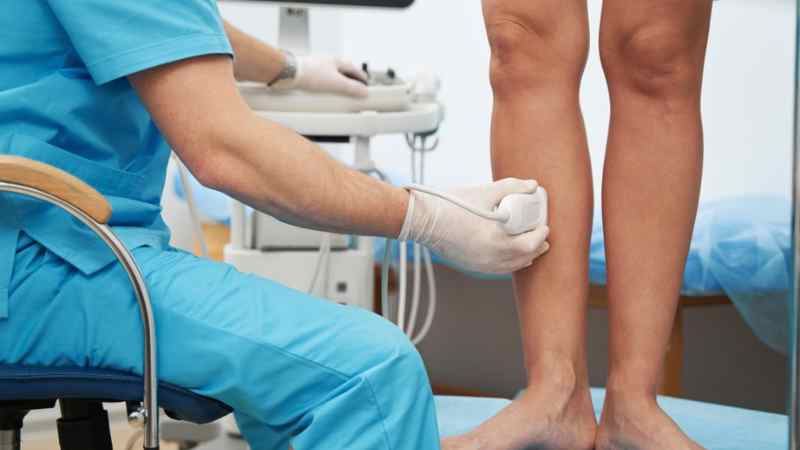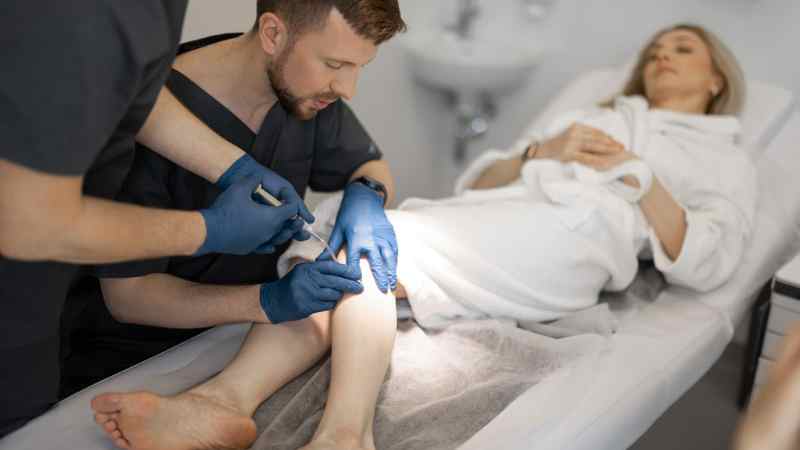Hello again, It’s Dr Rosen…I’m a vein specialist conveniently located in the North Shore suburbs of Chicago…and today is the latest installment in Rosen Vein Care’s Q&A Sessions on Varicose and Spider Veins.

Today’s topic: “How are varicose veins on the legs treated?”
First, let’s define our terms:
Varicose veins
are those bulging, often twisty, enlarged veins at the surface of the skin. They start off small…often in our teens…and can get progressively worse over time.
“Do both men and women get varicose veins?”
Absolutely! One of the most common factors that can lead to varicose veins is genetics. Mom or Dad can have them, and if either or both of them do/did, you can get them,too. What makes them somewhat more prevalent in women is thatwomen:
- Have more estrogen/progesterone hormones floating around than men. These can tend to make veins…that are already stretchy by nature…even stretchier.
- Have WAY more pregnancies than men. Pregnancies can make veins worse because:
- There’s even more estrogen/progesterone floating around to support the pregnancy
- There’s a larger volume of blood to help support baby
- Baby keeps growing inside the pelvis; this can make it harder at times to drain the flow out of the legs that’s trying to return back to the heart.
Now that we have a sense of WHO gets varicose veins, lets talk a bit more about why
they can happen.
When patients come to see me for their initial consultation appointment, the first thing I have to sort out is whether or not their varicose veins are just an isolated nuisance at the surface…OR…if they are just the “tip of the iceberg” of a problem that is lurking beneath the surface.
There’s a few clues that help me decide if it’s worth going hunting for underlying issues:
- Are there SYMPTOMS along with varicose veins? Symptoms are typically worse at the end of the day and often include
- “heaviness”
- “tiredness”
- swelling
- leg cramps
- “restless legs”, especially at night
- ache
- Is there a strong FAMILY HISTORY of signficant vein disease? Did a close relative ever need vein procedures in the past?
- WHERE are the varicose veins located? Are they in a territory that commonly suggests underlying problems?
If one or more of those clues are true for a particular patient, I’m more likely to suggest delving beneath the surface in order to look for underlying problems.
“OK…so once you decide to go looking, how do you look?”
Lower extremity veins are most easily, affordably and safely evaluated by using an ultrasound machine. Ultrasounds are a painless way of looking beneath the surface of the skin in order to see how veins course through the legs…but they are also able to assess the direction of venous flow.
Let’s back up a sec and briefly talk about
How Veins Work:
Veins have basically 2 main jobs:
- Store extra blood for when you might need more later…kind of like a reservoir.
- Send flow back towards the heart.
It’s super easy for veins at or above the level of the heart to return the flow: gravity does a lot of the work
BUT…for veins below the level of the heart…especially if you start moving further out towards the feet…blood flow has further to go… AND…when you are sitting upright or standing…the flow has to go upwards AGAINST GRAVITY. A tough job to do…especially since we dont have a heart pumping away in our feet/legs to send the flow upward.
Or do we?….[cue ominous kettledrumroll]
It turns out that we sorta do. Our body uses our calf muscles as a “peripheral heart” pump. Each time we move our ankles up and down [try it now, its fun!], our calf muscles contract and relax. When they contract, they squish things around them, like veins. This squish creates a force that propels the blood upwards and towards the heart.
That’s great and all, but gravity still acts to make the flow go back downwards.
SO…our veins are clever enough to have thought of this and are equipped with a series of one-way valves that open to allow upward flow and close to block downward flow from pooling in those stretchy leg veins.
“Cool!”
Yeah, unless the valves are broken…see genetics, pregnancies, etc above. If the valves don’t effectively block that downward flow with gravity, blood will pool in leg veins and make them stretch out.
If you think of leg veins as a “tree”, these valve problems often start at the trunks…typically within the superficial venous system in veins called the Saphenous Veins. These “trunk” veins often have numerous “branches” that lead to the surface. Over time, those surface branches get stretched out, twisty and can bulge…sound like varicose veins? That’s because they are!
While isolated varicose veins can also cause symptoms, when I hear about those symptoms I detailed above…”heaviness”, fatigue, etc….those are often the signs of valve issues in the relatively deeper saphenous veins.
“So…Dr. Rosen…are you going to eventually answer the question of HOW ARE VARICOSE VEINS TREATED?!”
Sure thing. Now we can literally be on the same page. Once we determine the source/depth of the problem, we can tailor a treatment plan to address the issue in a systematic way. While there are some docs…leg by a group out of France…who have a strategy of varicose vein treatment that tries to spare the saphenous veins and just treat the varicose branches first…the CHIVA strategy…most docs in the U.S. opt to treat the underlying flow problem in the saphenous veins first and THEN “clean up” the surface varicose veins.
We’re going to skip discussing the treatment of Superficial Venous Insufficiency(or valve malfunction) today. If I’ve whet your appetitie about this, feel free to check out my website and discover Endovenous Laser Ablation & Clarivein®…2 state-of-the-art, minimally-invasive, non-surgical treatment methods that I perform regularly.
For now, lets talk about the 2 most common methods for dealing with varicose veins: surgical and non-surgical approaches.
- Surgical: Phlebectomy, “microphlebectomy”, “ambulatory phlebectomy”…they all basically mean the physical removal of veins through (hopefully) small wounds. These are pretty straightforward, well-tolerated, generally safe procedures.
- Pros: Veins are typically immediately gone.
- Cons: You can be left with multiple (hopefully) small scars on your leg. Also can have a higher chance of infection, nerve injury, and other sequelae
- Dr. Rosen’s take on phlebectomy: I used to do them commonly and now I almost NEVER need to. That’s because choice 2 below is so effective…
- Non-surgical: Sclerotherapy
- Pros: Makes veins shrivel up and go away. Depending on which chemical is used, it’s VERY well tolerated with minimal discomfort during the procedure and after. Typically costs less than phlebectomies to get the job done. Costs can vary depending on the extent of the disease.
- Cons: Requires some patience. Other side effects can occur, but are pretty rare…allergic reactions to the chemical, skin discolorations,headaches and others. May require multiple sessions to get the job done.
My take on the process is this: Once I treat, when appropriate, any underlying saphenous venous valve issue in the area where the varicose veins have occurred, and THEN WAIT A FEW WEEKS for things to heal [called a “staged approach”]…varicose veins often shrink down to the point where they are very easily dealt with via sclerotherapy.
For Instance, From This to THIS: After 1 Endovenous Laser Ablation and 1 Sclerotherapy session
“Does Sclerotherapy hurt? Doesn’t it involve injections?”
Yes, it involves injections…and there truly is MINIMAL DISCOMFORT. The typical response I get after patients’ first treatment is something like “Meh…that was fine.”
After each sclerotherapy session, I recommend that patients wear compression stockings for 3 weeks from morning to night (the times when gravity is typically a factor). Whatever (limited) data there is, suggests that it’s a good thing to do. Patients are encouraged to be active. You can resume most activities, including most jobs, IMMEDIATELY after just about any treatments that I do…certainly sclerotherapy.
Well…that’s all for today’s Q&A Session. I think we covered a LOT of ground…hopefully you’ve enjoyed the ride!
If you are ready to finally deal with those annoying varicose veins, now is a great time to get evaluated…to take the first step on the road to legs that feel and look better than they have in years!
CALL 847-272-8346 OR CLICK THE BUTTON BELOW to Schedule Your Initial Consultation appointment with me.
Request Consultation Appointment

